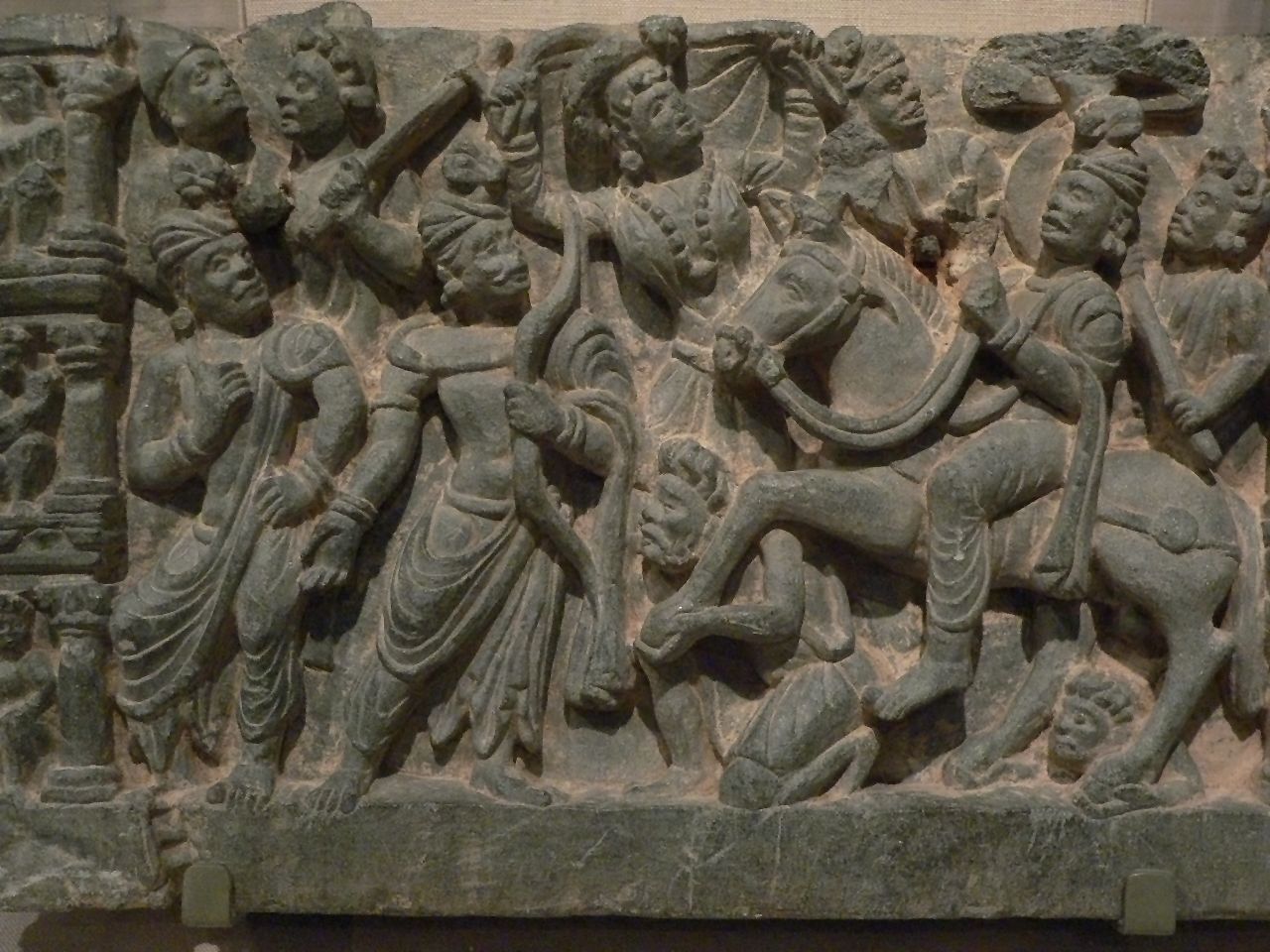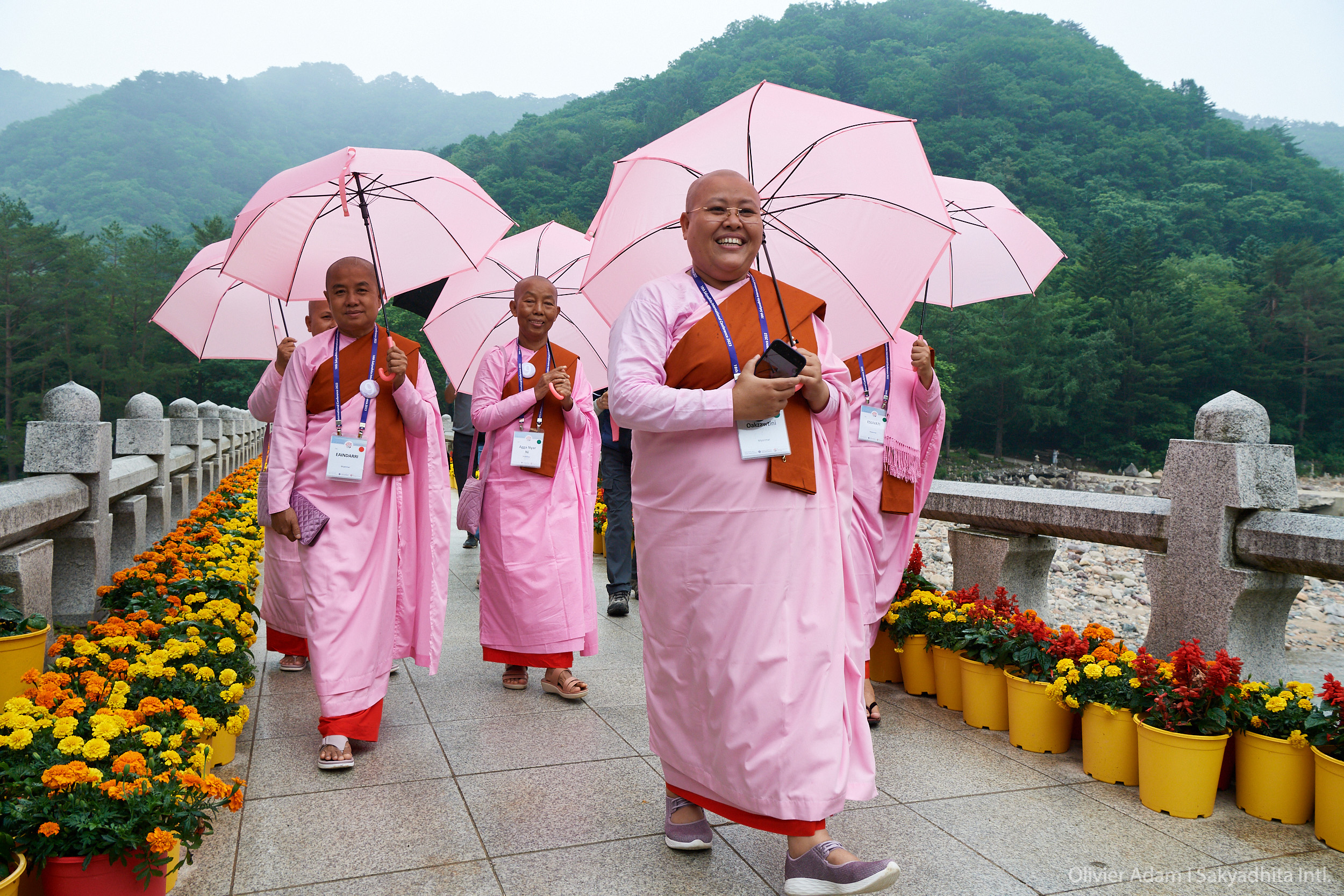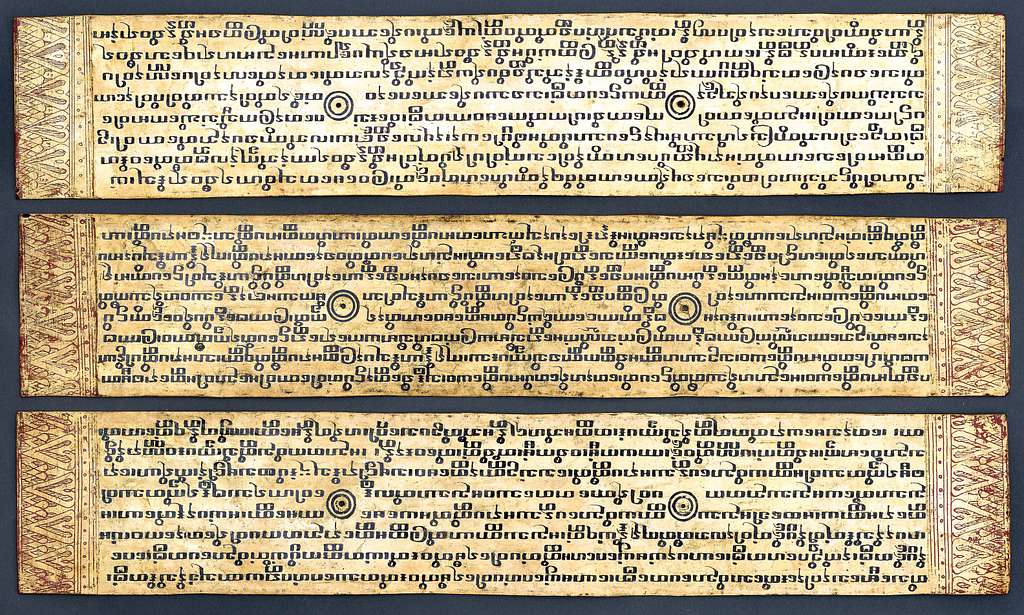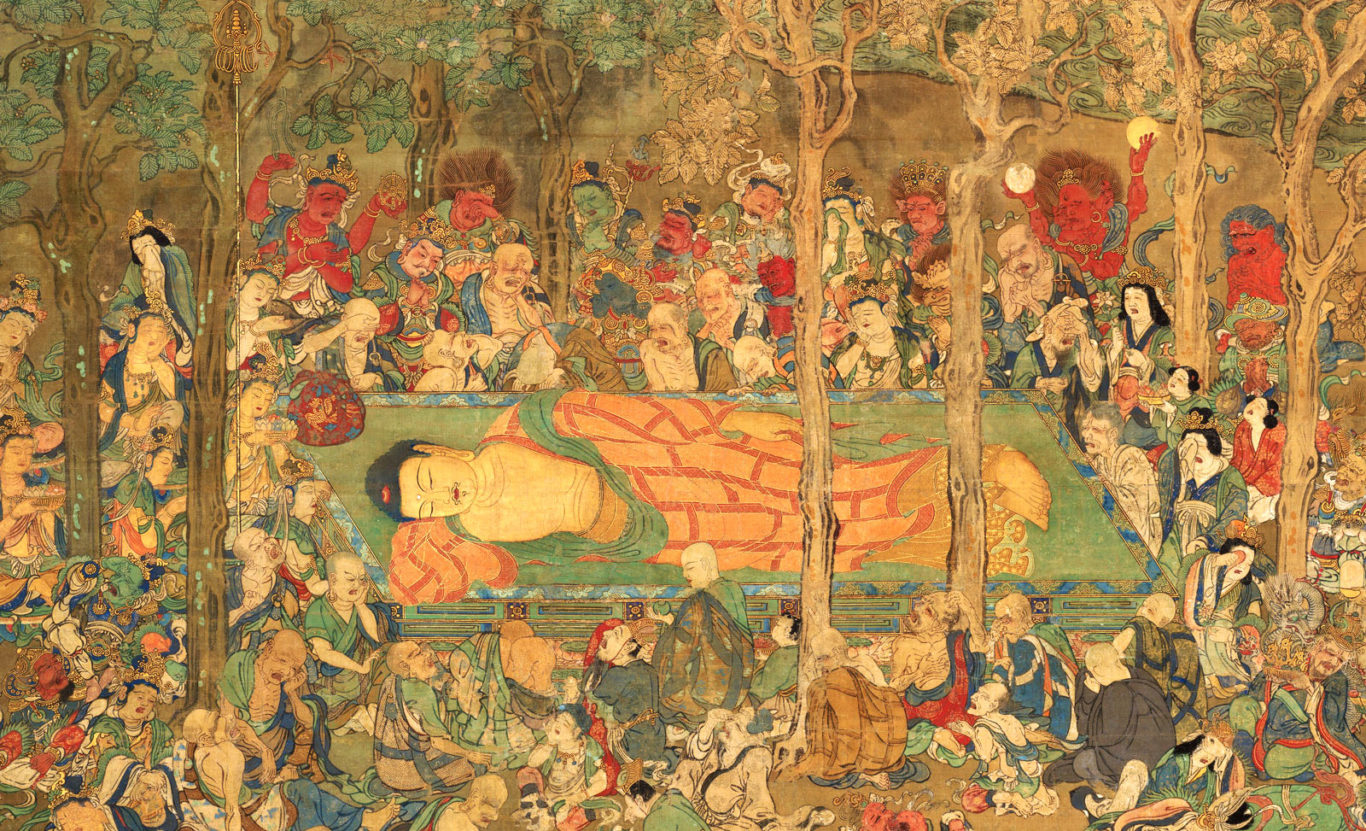

Buddha
For over 2,000 years, people across cultures have been inspired by the Buddha’s life. But who was he, really? This article explores the stories of the Buddha’s many lives, his path to enlightenment, and how his life continues to guide practitioners on the path to freedom from suffering. Whether you’re new to Buddhism or just curious to learn more, you’ve come to the right place.
Table of contents
Buddha’s Past Lives

According to Buddhist teachings, all beings cycle through birth and death, known as the endless cycle of samsara. The Buddha was no exception. However, stories of his past lives, told in jataka (birth) tales, reveal a pretty remarkable being. There are more than 500 jataka tales across Buddhist traditions, each illustrating virtues he perfected on his path to enlightenment.
In his past-life stories, the Buddha takes birth as a wide range of beings—humans, animals, and deities—demonstrating selflessness, compassion, wisdom, and determination. He appears as a king, a sage, and even a criminal, as well as an elephant, a deer, a monkey, and a bird. Some tales feature dramatic sacrifices: In one, he gives his body to a starving tigress to save her cubs; in another, as a rabbit, he leaps into a fire to feed a hungry mendicant, who turns out to be the god Shakra (Indra). The god, moved by his generosity, marks the moon with the image of the rabbit in tribute.
One of the most famous jataka tales tells of Sumedha, a wandering ascetic who encounters Dipankara Buddha, an enlightened being of a past age. Seeing Dipankara and his followers approaching, Sumedha offers his long locks of hair and his body as a path across a muddy road. While being trampled, Sumedha vows to perfect himself as a buddha in a future lifetime—an aspiration Dipankara confirms will come true.
Some stories confront controversial topics. In one, the Buddha is a ship captain who kills a would-be murderer to save 500 passengers. While this act prevents suffering, some versions of the tale suggest that even compassionate killing lands him in hell for eons. Another controversial jataka is the tale of Prince Vessantara, whose generosity leads him to give away everything he has, including his children.
Over the centuries, jataka stories and local folktales mixed together, covering a variety of themes also found in the Indian Panchatantra (an ancient Sanskrit collection of animal tales) and in Aesop’s Fables. Though varying by tradition, jatakas are a rich source of legendary information about the Buddha’s previous lives. Many texts describe his previous existence in Tushita Heaven, where he prepared for his last rebirth as Siddhartha Gautama, the buddha of our time.
Birth of the Buddha

Although the Buddha is described as human, nothing about his birth was ordinary, according to the many Buddhist texts that celebrate his life. Even the earliest fragments of his story that have come down to us in various ancient sources weren’t written down until centuries after his birth, so it is impossible to know with certainty who he was. Over time, however, it is clear that his story has acquired increasingly colorful mythic elements, depicting the Buddha as almost superhuman.
Before he was born as Siddhartha Gautama, the Buddha is said to have spent countless lifetimes as a bodhisattva, or an enlightened being on the path to awakening. Over eons in various incarnations, he perfected the ten transcendent virtues (Skt.: paramitas; Pali: paramis) that all buddhas-to-be must cultivate before attaining nirvana (liberation from suffering).
When the bodhisattva decided to enter the human world for his final birth, he chose Suddhodana and Maya as his parents. Suddhodana was a powerful leader of the Shakya tribe, and Maya was his wife. One day, Maya dreamed that gods carried her to a temple and bathed her. As she lay on a couch, a white elephant with six tusks entered her right side, signaling the bodhisattva’s miraculous conception.
Later, on her journey to her childhood home to give birth, Maya stopped in Lumbini Grove, where she gave birth standing and holding a tree branch. The child emerged from her side, radiant and clean, captivating all who gazed upon him. He took seven steps and declared to the four directions, “I am supreme in the world. This is my last birth. Henceforth, there will be no rebirth for me.” The earth shook, light filled the cosmos, and many other miraculous events marked his arrival in the world.
Hearing these wonders, the renowned ascetic Asita told Suddhodana the child would become either a universal ruler (Skt.: cakravartin; Pali: cakkavattin) or a great awakened teacher—if he chose to renounce his worldly life. Realizing that he was too old to live long enough to hear him teach, Asita wept with joy and sorrow, knowing Siddhartha’s future greatness. The Buddha’s father, Suddhodana, was concerned, however, because he wanted his son to become a powerful ruler like him.
Soon after Siddhartha’s birth, Maya died, and the boy was raised by her sister, Prajapati Gotami, who later became the first Buddhist nun. The Buddha’s miraculous birth stories remind us of his supernatural presence, inspiring countless generations on the path to liberation.
Life Before Enlightenment

Siddhartha grew up in luxury in Kapilavastu, the capital city of the Shakya clan, situated at the foot of the Himalayas in modern-day Nepal. His upbringing was one of privilege, comfort, and power. His father, Suddhodana, was a tribal leader. Although he is often described as a king, contemporary research suggests the region was more of a republic governed by a ruling council, making him more of an oligarch than a monarch.
Siddhartha was raised in splendor, and some accounts say he had a palace for each season. Pleasures surrounded him: a harem of beautiful women, the purest waters (a big deal before modern water treatment), and the finest food. Since the prophecy foretold that Siddhartha would either become a powerful ruler or an awakened teacher, to ensure that his son became a ruler, Suddhodana also taught him the arts of war and statecraft, determined to satisfy the boy’s every material need and keep him attached to a life of power and wealth.
Despite his luxurious surroundings, Siddhartha remained disciplined and virtuous. He was described as perfect in looks, skills, and behavior. He spoke kindly, acted wisely, and inspired those around him. He carried the thirty-two characteristics of a great man, the physical characteristics that marked him for greatness. In school, he surpassed his teachers in knowledge and understanding. He was also renowned as the best archer among the Shakyas.
Siddhartha married Yasodhara, who, according to some stories, was a goddess sent to be his consort. Jataka tales depict them as husband and wife through many past lives. Yasodhara gave birth to their son, Rahula, meaning “fetter,” symbolizing Siddhartha’s ties to worldly life.
Yet neither luxury nor family satisfied him. Stories tell us he longed to see life beyond the palace walls, and his life would change forever when he did.
Renunciation

Siddhartha’s renunciation is one of the most well-known stories in the Buddhist tradition, marking his transformation from prince to religious seeker. For twenty-nine years, Siddhartha lived in luxury, shielded from the harsh realities of life by his father. He hoped to anchor Siddhartha in worldly pleasures, ensuring he became a powerful ruler and continued the family tradition. But Siddhartha grew restless and curious about the world beyond the palace.
As one popular version of the story goes (and several versions exist), Siddhartha’s life took an irreversible turn after taking excursions beyond the palace walls, when he encountered “the four sights”: an old man, a sick man, a corpse, and an ascetic. These encounters profoundly disturbed him. He realized that aging, illness, and death were universal and inescapable, and he was shocked that people could carry on with life in the face of such suffering. But seeing the ascetic—calm, detached, and at peace—gave him hope that there might be a way to solve the problem of suffering and go beyond the endless cycle of birth and death.
Soon after, Siddhartha resolved to leave his royal life and set out in search of an end to suffering. In the early morning, he quietly left the palace, his family, and all the privileges he had ever known. He exchanged his fine clothing for a simple robe, cut his hair, and began the life of a wandering ascetic.
Perhaps the most poignant part of the story is Siddhartha’s departure from his wife, Yasodhara, and their infant son, Rahula. Stories depict Yasodhara experiencing great sorrow and pain. Siddhartha’s decision to leave them reflected an inner conflict that many texts characterize as both painful and courageous. His choice was not made lightly but with a duty to find a path that would benefit all beings. Later, Sri Lankan narratives detail that Yasodhara also attained enlightenment within the palace.
Siddhartha’s renunciation was both literal and symbolic: a physical departure from the palace and a rejection of a life predestined for him. It was a radical commitment to seeking answers to life’s most existential questions—no matter the cost.
Six Years of Asceticism

After renouncing palace life at 29, Siddhartha began six years of intense ascetic practices. He was determined to understand the nature of suffering and find a way to its end. His journey away from the palace led him to study with two famous yoga masters, Arada Kalama and Udraka Ramaputra, who taught various meditative techniques. Siddhartha mastered their practices and attained high states of meditative awareness, but he realized these states were temporary and did not solve the problem of human suffering or bring lasting liberation.
Still searching for answers, Siddhartha joined five wandering ascetics (Skt.: sramana), who believed extreme self-denial could lead to enlightenment. He pushed his body to the limits of endurance—fasting until he was said to live on a single grain of rice a day, holding his breath for long periods, and exposing himself to pain and hardship. Centuries later, images of his emaciated body became iconic in Buddhist art, symbolizing his unwavering determination.
But after years of severe austerities, Siddhartha understood that neither indulgences in pleasure nor extreme deprivation led to the truth. This insight led him to discover what would later be called the middle way: a balanced path between self-indulgence and self-mortification.
As one story goes, Siddhartha’s turning point came on his 35th birthday, when a woman named Sujata saw his weakened form and, mistaking him for a tree spirit, offered him a bowl of sweetened milk rice pudding. He accepted the offering, bathed in the nearby river, and regained his strength. Seeing him eat and abandon their harsh practices, his five companions believed he had given up the quest for enlightenment and left him.
But Siddhartha had not abandoned his goal. Instead, he was preparing for a new approach. His discovery of the middle way became the foundation of his teaching and his path to awakening. Restored and resolute, he was ready to seek the answers he had long pursued.
Enlightenment

After six years of intense asceticism, Siddhartha sat beneath the Bodhi tree and resolved not to rise until he solved the problem of human suffering. Letting go of extreme practices, he turned inward, determined to understand the nature of life and liberation.
Siddhartha’s unwavering resolve drew the attention of Mara, the personification of delusion and desire. With his three sons—Agitation, Excitement, and Pride—and his daughters—Discontent, Delight, and Thirst—Mara set upon Siddhartha, unleashing armies of demons, terrifying visions, and sensual temptations. Mara’s psychological assault on Siddhartha was formidable, trying to distract Siddhartha with promises of power and pleasure. But Siddhartha remained unmoved. Mara released volleys of arrows, but Siddhartha turned them into lotus petals. Realizing the onslaught was illusory, he defeated Mara and scattered his armies. The earth shook, the heavens rejoiced, and numerous miracles and fantastical events happened.
Afterward, Siddhartha experienced a series of realizations in a deep state of meditative calm. First, he recalled countless past lives, witnessing the endless cycle of birth and rebirth shaped by karma. Second, he saw the unfathomable intricacies of how karma operates, determining the fates of beings across lifetimes. Third, he grasped the four noble truths: the truth of suffering, its cause, its cessation, and the middle way leading to its end—the eightfold path. With this final insight, Siddhartha attained complete and total enlightenment (Skt.: samyaksambodhi), becoming the Buddha, the Awakened One.
Yet, even in his awakening, one doubt lingered. He wondered if anyone could truly understand the depth of his realizations. It seemed too difficult for others to grasp. Seeing his hesitation, Brahma, a powerful deva in the Indian pantheon, appeared and implored the Buddha to teach for the world’s benefit. Convinced by Brahma’s pleas, the Buddha agreed. Brahma’s nudging is seen as a divine endorsement of the Buddha’s awakening and a recognition of its universal importance.
The story of the Buddha’s enlightenment weaves together myth and human experience, narrating a journey that transcends the ordinary and continues to inspire seekers on the path to liberation.
First Followers

After Brahma’s plea convinced him to share his realization, the Buddha surveyed the world with his penetrating insight to find his first students. His two former teachers had died, but his five ascetic companions were nearby, in Deer Park, near Varanasi. He set out to find them.
On his way, he met an ascetic Upaka, who was struck by the Buddha’s serene presence and asked, “Who is your teacher?” The Buddha explained that he had no teacher; he had surpassed all others. Upaka was not impressed. He replied, “That may be true, friend,” nodded his head, and went on his way.
When the Buddha reached Deer Park, he found the five ascetics: Kaundinya, Asvajit, Bhadrika, Mahanaman, and Vaspa. They had abandoned Siddhartha when he accepted the offering of food and renounced their severe asceticism, and so at first, they ignored him. But seeing his radiant presence, they welcomed him to sit and speak.
The Buddha delivered his first sermon, the Dhammacakkappavattana Sutta, or Setting in Motion of the Wheel of Dharma. In it, he describes the middle way between extremes, the four noble truths, and the eightfold path. These teachings explained the cause of suffering, its cessation, and the path to liberation.
After hearing this sermon, Kaundinya realized the truth of the dharma and became the Buddha’s first disciple. The Buddha then delivered a second sermon, the Anattalakkhana Sutta, or the Discourse on the Non-self Characteristic, which explained the three marks of existence: impermanence (anicca), suffering (dukkha), not-self (anatta). After hearing this, the remaining four ascetics also awakened to the truth. Again, the earth shook, and many miraculous signs occurred.
The Buddha invited them to join him, saying, “Come, monk, the dharma is well proclaimed; live the holy life for the complete ending of suffering.” This marked their ordination and the beginning of the Buddhist sangha, or monastic community.
These five disciples became the first monks, and the Buddha’s teaching career began with their awakening—a journey that would last another forty-five years.
The Buddha’s Original Teachings

The earliest surviving teachings present a picture of Buddhism that might surprise many today. Far from the life-affirming, community-centered ethos popular in modern Buddhism, early Buddhist teachings were intensely renunciatory. They emphasized leaving behind family and worldly life. The model of the wandering mendicant was the path the Buddha recommended as the surest way to end suffering.
The focus on renunciation was a response to the dominant Brahmanical traditions of his time, which stressed ritual and caste. Early Buddhism offered a radically different approach—one grounded in personal effort, ethical conduct, and meditative practice, not social status or ritual.
Some of the oldest scriptures, such as the Suttanipata, provide glimpses of these early teachings. Within the Suttanipata, the Atthakavagga and the Parayanavagga are often seen as among the earliest Buddhist texts. They depict an austere, individualistic practice aimed at cutting off all attachments—including attachment to views and doctrines.
One well-known early text, the Rhinoceros Sutra (Khaggavisana sutta), praises solitary life, likening the practitioner to a rhinoceros who wanders alone. Much of the early teachings encourage detachment from all positions and views—even Buddhist ones—as a means of transcending suffering. While this ideal was long assumed, evidence suggests that early monks and nuns lived in groups and maintained some contact with their families.
Like the life of the Buddha himself, the structure of early Buddhist communities will always remain somewhat uncertain, as the ancient writings we do have are not historical records. They were written long after the Buddha’s death, shaped by the concerns and cultures of their time. Still, they provide valuable insights and continue to guide those seeking the Buddha’s path.
Learn about what the Buddha taught.
Accepting Women into the Order

The Buddha’s decision to admit women into his monastic order was an important moment in the narrative of his life and the history of Buddhism. On the one hand, it offered women a formal place on the Buddhist path to liberation; on the other, it came with conditions that placed them in a subordinate position to male monastics. This decision reflects both progress and ongoing challenges for women in Buddhist communities.
According to texts written centuries after his death, the Buddha’s aunt and stepmother, Pajapati Gotami, inspired by his teachings, sought ordination. She led a large group of women to request the establishment of a female monastic order. The Buddha refused—several times. In some stories, particularly in the Pali canon, he predicts that allowing women into the sangha will accelerate the decline of his teaching. With their ordination, the dharma would begin diminishing after only 500 years instead of 1,000.
Pajapati and her followers persisted. They shaved their heads and adopted the life of wandering mendicants, typically reserved for men. Ananda, the Buddha’s cousin and attendant, intervened. He asked the Buddha whether women were capable of enlightenment. The Buddha agreed they were and eventually relented—on the condition that women accept an additional eight “heavy rules” (garudhammas) that placed them in an inferior position to the men, regardless of seniority. Pajapati accepted, becoming the first fully ordained Buddhist nun, or bhikkhuni.
The Buddha’s decision reflected the patriarchal norms of his time, and the eight heavy rules have been the subject of ongoing debate. Some scriptures go further, suggesting that buddhahood is impossible in a woman’s body and that rebirth as a man is required to achieve complete enlightenment.
Despite these limitations, women played a significant role in early Buddhism. Many were respected teachers, and their verses are recorded in early Buddhist texts like the Therigatha, a collection of poems by nuns. However, over time, women’s orders declined and disappeared in South Asia. Reviving bhikkhuni ordination today remains controversial in some traditions.
The story of the Buddha’s acceptance of women into the sangha marks a significant, if complicated, chapter in Buddhist history. It highlights his willingness to challenge societal norms and the persistence of gender inequalities that continue to shape Buddhist practice today.
Buddha the Problem Solver

As the monastic community grew, the Buddha faced an all-too-human problem: misbehavior. The early sangha was not immune to the challenges of communal life, from sexual misconduct to theft to incivility. The Vinaya Pitaka, the Buddhist code of monastic discipline, addresses these issues, offering rules and the stories behind them. Together, they reveal the Buddha’s role as a compassionate problem solver, working to create harmony within the community.
The Vinaya is one of the principal components of all Buddhist canons, a primary source of the Buddha’s teachings, and an essential part of monastic life. Though often viewed as strict, the Buddha’s rules are grounded in compassion, respect, and mindfulness lessons. The stories that accompany them are vivid and sometimes shocking. Monks gambled, stole, lied, cursed, masturbated, and had sex. Some falsely claimed enlightenment; others engaged in indecent acts with statues—or worse. Even acts of murder, necrophilia, and zoophilia appear in these accounts. These tales may seem extreme, but they illustrate the complexities of maintaining ethical standards in a large community.
Traditionally believed to be the words of the Buddha, scholars argue that the Vinaya Pitaka was compiled long after the Buddha’s time, suggesting that it tells us more about the concerns of maintaining institutional order and decorum rather than the Buddha’s teachings. The Buddha reportedly did say that minor rules could be changed or discarded. But since he never clarified which rules were “minor,” most communities kept everything intact. Today, the Vinaya remains relevant. Becoming a monastic still requires declaring one’s willingness to follow the Buddha’s rules, and the Vinaya continues to be recited in monasteries and temples.
For modern practitioners, learning about the Vinaya reveals the Buddha as a great dharma teacher and a practical leader dealing with the messy realities of human behavior and communal life. His approach reminds us that Buddhist practice is not a solitary journey of seated meditation but also a communal one, where our actions and choices affect the people and health of our community. For most traditions, the Buddha’s code of conduct is a critical component of the practice and the starting point for setting out on our road to awakening.
Death of the Buddha

Teachers die, and the Buddha was no different. His death at 80 was one of the most significant events in the history of Buddhism, as it exemplified his teachings on impermanence, suffering, the path to enlightenment, and liberation. Stories of his death have been passed down in sutras, narratives, sculptures, and paintings, most notably in the lengthy Mahaparinirvana Sutra (Sutra on the Great Final Nirvana). Part of the Mahayana tradition, this text teaches about nonself (anatman), buddha-nature, and the eternal dharmakaya, or dharma body of the Buddha.
The stories often begin with the Buddha traveling and teaching during the monsoon rains. He becomes ill with sharp abdominal pains, likely from dysentery. As his disciples grow anxious about losing him, the Buddha reassures them that he has accomplished what he set out to do and withheld nothing in his teachings. He tells them to take refuge in the dharma as their guide.
At several points, the Buddha hints to his cousin and close attendant, Ananda, that if asked, he could continue living for an eon. But Ananda misses the hints, something that still haunts his reputation. Mara, the god of delusion, visits and urges the Buddha to leave the world. The Buddha, unswayed by Mara, resolves to die after three months, when his disciples would be more ready. A colossal earthquake rocks the heavens and the earth. When Ananda finally begs him to stay, it is too late.
In his final days, the Buddha accepts a last meal from the blacksmith Cunda, which causes him severe diarrhea and intestinal pain. Despite the pain, the Buddha remains composed, radiating a golden light throughout the heavens. He travels to Kusinara, lies between two Sal trees, which burst into bloom, and gives his final teachings: All conditioned things decay; strive diligently for liberation. He then dies, passing into final nirvana (parinirvana). A second earthquake rocks the cosmos, and divine beings gather to honor him.
His death, while a moment of grief, underscores his central message—that freedom from the cycle of death and rebirth is possible. His passing is commemorated annually worldwide, reminding Buddhists of life’s impermanence and the enduring value of his teaching.
After the Buddha’s Death: Buddhist Relics

Although the Buddha spent forty-five years teaching about impermanence and the suffering caused by attachment, his followers still longed for his continued presence after his death. His final nirvana gave rise to one of Buddhism’s most enduring practices: the veneration of relics.
Relics are sacred objects, often physical remains, such as bones or teeth, or items associated with holy figures, like robes or ritual implements. Followers believe that relics hold the essence of the Buddha’s enlightenment and can offer blessings or protection. Shrines housing relics became pilgrimage centers, and legends surrounding them abound—even battles have been waged over relics!
After the Buddha’s cremation, his remains were divided. Teeth, bones, and ashes became coveted relics believed to retain his spiritual power. Disputes arose among various clans over who would claim them. A man named Drona (Skt.; Pali: Dona) intervened, dividing the relics among the eight clans, who enshrined them in stupas—burial mounds—in their territories. Even divine beings sought some relics, hiding them away in heavenly realms.
After some time, a powerful ruler named Ajatasatru is said to have gathered the relics and placed them in a single reliquary in Rajagaha (modern-day Rajgir). To protect them, the deity Visvakarma created sword-wielding wooden robots to guard the reliquary from thieves.
Centuries later, the Mauryan Emperor Ashoka (c. 3rd century BCE) played a central role in relic history. According to legend, he broke into Ajatastru’s reliquary with the help of a god, claimed the relics, and built 84,000 stupas throughout his empire to house them.
Relic stories of devotion, miracles, intrigue, and sometimes violence have continued to the present. In 1561, Portuguese Catholics reportedly destroyed a tooth relic in Goa, India, though Buddhists insisted it was a fake, and the actual tooth miraculously remained in Sri Lanka. In 2015, Bodhi Light International displayed its “10,000 Buddha Relics Collection,” including a tooth of the Buddha covered in mysterious, colorful crystal spheres, at a temple in Pasadena, California, attracting pilgrims from around the world. And in 2025, relics of the Buddha were auctioned off to the highest bidder.
The significance of these relics transcends their physicality and historicity. They demonstrate an attachment to the Buddha while simultaneously symbolizing his life, teachings, and the ultimate impermanence of existence. They are also reminders that life is short and, in the end, we are all just bits of bone and ash.
Buddhism for Beginners is a free resource from the Tricycle Foundation, created for those new to Buddhism. Made possible by the generous support of the Tricycle community, this offering presents the vast world of Buddhist thought, practice, and history in an accessible manner—fulfilling our mission to make the Buddha’s teachings widely available. We value your feedback! Share your thoughts with us at feedback@tricycle.org.



